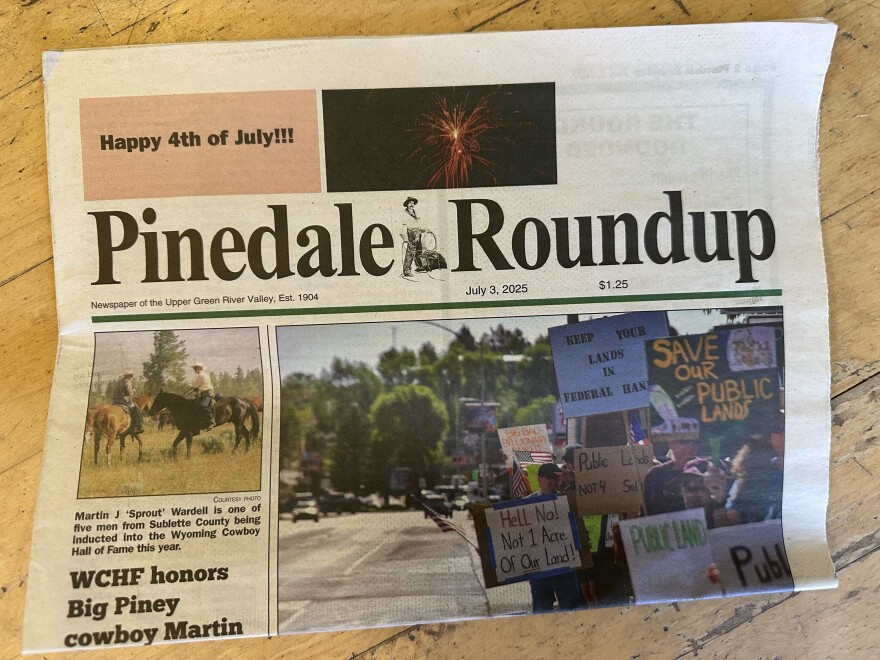Eight newspapers across Wyoming will stay open after their parent company announced they were shutting down nearly a week ago. Longtime local newspaper executives with Wyoming roots announced plans on Aug. 12 to intervene and keep them running.
That includes papers in Niobrara, Goshen, Platte, Uinta and Sublette counties.
Pinedale Roundup Editor Cali O’Hare said all the fired employees got on a phone call on Tuesday to hear the good news from their News Media Corporation (NMC) publisher Rob Mortimer, who’s based in Torrington. He told them he was partnering with Jen and Robb Hicks, publishers of the Buffalo Bulletin, to rescue Wyoming’s newspapers.
”As you can imagine, a phone call with 30-some-odd people who were just laid off last week and spent the last six, seven days working nonstop to find a solution,” said O’Hare. “Just screaming and woo hoos and people were so excited. It was really such a special moment for us and for our team.”

This all comes after the previous owners, the Illinois-based NMC, which called itself “the voice of small town America,” abruptly shut down operations amid financial problems, a trend among big media groups.
The company did not respond to requests for comment. NMC owned dozens of newspapers across five states.
During the past week behind the scenes, the Wyoming Press Association and news organizations around the state scrambled to find a rescue plan. They didn’t want the eight papers to lose their ability to include public legal notices. State law says newspapers have to publish at least once a week — for 52 weeks in a row — to be eligible for this revenue stream.
But this same groundswell of support hasn’t been reported in Arizona, Illinois, Nebraska and South Dakota, the other states that lost papers in the recent shutdown.
“It seems to me like [these companies] care perhaps less about the communities that they report on and more about maybe their shareholders,” said Corey Hutchins, who manages the Journalism Institute at Colorado College and reports on the media industry.
He said locally-owned papers are also feeling the squeeze with fewer advertisers and subscribers, but they often sound the alarms for help before throwing in the towel, and the community may step up like it did in Wyoming.
“And say, ‘Hey, I'll even pay more for the paper, so we can keep you around because we know how valuable you are,’” Hutchins said.
Research shows that there’s less civic engagement and more government corruption in communities that have lost papers.
Hutchins said there’s a massive squeeze on all types of local news right now.
“You have these large corporate television broadcasters that are consolidating. Those usually lead to layoffs,” he said. “You have public broadcasting under threat from the current presidential administration. And at the same time … now you've got newspapers blinking out in communities left and right.”
But Hutchins said it’s not all bad news.
Local outlets are increasingly collaborating, instead of competing, to not duplicate efforts and better serve readers. Plus, he’s hopeful that college students could help fill gaps in neighboring communities, and communities — like the ones in Wyoming — will continue to step up to keep papers afloat.
As for Cali O’Hare, she was amazed by the level of community support.
“We had people coming in [to the newspaper office] who wanted to offer money to help us buy it. We had a couple of people who were attorneys just reaching out to give us some pro bono advice. We had executive directors of local nonprofits reaching out and saying, ‘Hey, if you're interested in going a nonprofit route, we could help you file that. So a tremendous outpouring of support, reaffirming their desire to continue to have a published newspaper in Sublette County,” said O’Hare.
She reminded people across Wyoming to support their legacy newspapers by taking out subscriptions.
Editor’s note: Wyoming Public Media expects to lose 14% of federal funding because of cuts to the Corporation for Public Broadcasting, which is expected to shut down in the months ahead.
This story was in part produced by the Mountain West News Bureau, a collaboration between Wyoming Public Media, Nevada Public Radio, Boise State Public Radio in Idaho, KUNR in Nevada, KUNC in Colorado and KANW in New Mexico, with support from affiliate stations across the region. Funding for the Mountain West News Bureau is provided in part by the Corporation for Public Broadcasting.




